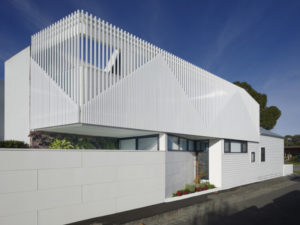Project Description
The Broad Street house is set within the picturesque coastal village of Orford in Suffolk. The clients are local residents who saw the potential of the site and aimed to replace the incongruous pre-existing 1980s building with an exceptional contemporary home that celebrated its locality and setting, and was tailored to them as ‘empty nesters’ who continue to work from home. The house also had to take full advantage of the extraordinary natural light and the extensive views across the marshes to Orford Ness, as well as the coast beyond.
The brief was fulfilled by designing a house with an open-plan living arrangement on the ground floor that provides them with spacious living and dedicated work rooms for their respective professional activities as silversmith and baker. The first-floor bedroom is designed to take in the spectacular views with 9-metre-long glazed doors, opening towards Orford Ness. Planning permission for the scheme was obtained at the first attempt with little local objection.
Externally, the new house responds to its context sensitively by using a palette of locally sourced oak cladding and handmade bricks. To create a more distinctive look, the bricks were laid in a variation of ‘Monk bond’, using white iron-free sand for the lime mortar, which was sourced from the local Wivenhoe pit. These traditional vernacular materials, with present-day detailing, blend with the historic architectural character of the village, whilst also creating a distinctive contemporary identity.The ground floor walls make use of innovative steel lintels and thermally decoupled in-situ concrete beams to form large recessed openings with brick soffits that are seemingly unsupported. This gives the appearance of a moulded solid mass of masonry that surprises and delights. In contrast to the brickwork on the ground floor, the upper level appears lightweight, using ribbons of untreated oak cladding to wrap up and across a pitched roof. The oak cladding was sized to match the dimensions of the brick course, so that the two elements of construction have a complementary design.
The ground floor of the house has been raised to mitigate the tidal flood risk, whilst the ridge height has remained the same as the original house. A hybrid of construction methods was therefore used to maximise ceiling heights, including concrete beam-and-block and cavity wall construction on the ground floor, and an in-situ exposed concrete first-floor slab with a timber frame construction above.
The house was also built to be energy efficient, with an air source heat pump, significant insulation and an MVHR system ventilating all rooms. The large glazed doors were designed with generous overhangs to address the southern orientation of the house, maximising winter light and minimising thermal gain during the summer.
Internally, the house has a modest decorative scheme with exposed concrete ceilings complemented by the use of natural timbers, including a floor of whitewashed Douglas fir planks, and fitted joinery made with plywood faced with lacquered birch. Whilst simple, this internal design aesthetic adds to the overall warmth and character of the property.









































